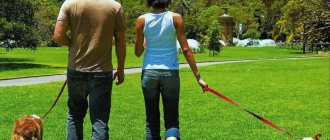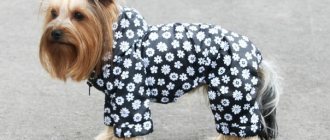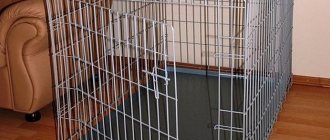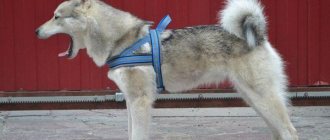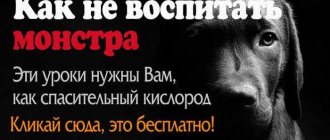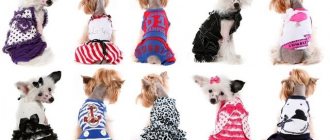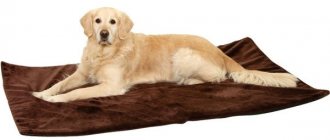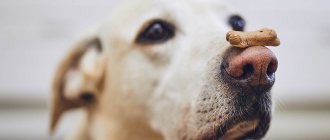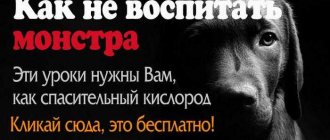DIY knitted hat for a dog
As you know, most owners of small dog breeds always try to insulate their pet in the winter. Moreover, it should be noted that dressing a dog in winter is not only a kind of fashion, but also simply a harsh necessity of life. The Chinese Crested, West Highland White Terrier or Yorkshire Terrier, as well as some other breeds, do not have a furry undercoat. Consequently, when walking in winter, such animals can easily get frostbite or catch colds.
By the way, a jacket, fur coat or hat for a dog is also needed in the summer. If in winter clothes protect against hypothermia, then in summer they will actively resist overheating of the animal.
What breeds
First of all, miniature dogs, especially short-haired ones such as Chihuahuas, dachshunds and pugs, need a headdress. They do not have natural protection from the cold, and high activity leads to rapid consumption of energy reserves.
The list of animals that require full equipment includes hairless breeds, as well as those from tropical regions (for example, native to Africa), which by nature cannot stand the cold. Usually they are not walked in winter, but if there is still a need to go for a walk, a jacket and hat are necessary to maintain the pet’s health.
For breeds with cropped ears, a hat is necessary because it helps prevent otitis media. In humid, snowy, frosty weather, it will protect your ears from cold and moisture getting into them.
Dogs with large ears require a hat in extreme cold, because due to the size of the ear, the wind can blow through the head too much, which can lead to otitis media.
Divers and swimmers are considered a separate category of breeds that need ear protection. These dogs require commercial rubber caps to prevent water from getting into their ears. When washing in the bathroom, you can use regular shower caps.
Other breeds can do without hats, but there are certain reasons that make a hat necessary:
- chronic otitis;
- weak immunity (postoperative rehabilitation or a previous serious illness can temporarily reduce the body’s protective functions).
Taking measurements
How to knit a hat for a dog? What actions are performed first? Of course, as with any other type of knitting, you need to make certain measurements before starting work. If things are much more complicated with suits and overalls, then even beginners never have any problems with taking measurements for a hat.
What parameters are needed? First, you will need to measure the animal's head circumference. Secondly, measure the distance between his ears. We will not make any additional measurements.
Jumpsuit for a small dog with knitting needles with raglan for a girl and a boy: diagram with description, photo
A jumpsuit for a small dog with raglan sleeves requires certain skills, as you will need to knit it with a smooth curve along the armhole line. Below is a diagram of such a jumpsuit.
Jumpsuit for a small dog with knitting needles with raglan for a girl and a boy: diagram with description, photo
Jumpsuit for a small dog with raglan sleeves Dog Clothes
The trouser legs are knitted separately in the form of rectangles. The length of these parts is equal to the circumference of the dog’s hind legs. Sew the trouser legs only along the outer edge. Pants are not sewn between the dogs' legs.
Striped jumpsuit for a small dog
Jumpsuit for a small dog with knitting needles with raglan for a girl and a boy: photo of a red jumpsuit.
Overalls for a girl's dog with raglan
To cover or not to cover your ears
Some experts recommend always knitting hats with slits for ears. Dogs, as you know, are proud and value their hearing, so their owners must protect it. A dog's hat should not press or put too much pressure on the ears. It's better to make small slits. If the hat is too tight and dense, then the dog simply will not hear the owner, his hearing will become dull, and he may get lost.
There are other cases. For example, when your dog has very sensitive ears that tend to catch colds. In this case, as you understand, it is better to choose a hat model with closed ears. They will be protected from the wind, and the animal will not experience any discomfort after the walk.
Knitting patterns for dogs
It is often recommended to knit hats with holes for ears. Especially when the pet has erect ears. But, if you knit the hat not too tight, it will not press or press the ears too hard. In addition, during a walk, the ears will be protected from wind and cold, and the dog will not experience any discomfort. This is especially true for dogs with sensitive ears that are prone to ear infections.
You should not knit a hat that fits too tightly to your head. Not only will the pet experience discomfort, it may simply not hear the owner and get lost.
This model of dog hat is good because it will not fly off the head. In addition, a restless four-legged animal will need to try very hard to pull the hat off its head.
We suggest you read: The best way to feed chickens in winter Grain mixture for laying hens composition
In addition to the above properties of clothing made from yarn, it is worth highlighting the differences between the following things:
- practicality, versatility.
- aesthetics.
- uniqueness.
- Possibility of application in many situations.
- Based on the volume of the chest, we cast on loops. The approximate number for a toy terrier is 88 loops.
- Start knitting from the collar area. If your toy terrier is a mini, then reduce the number of loops by 20 pieces.
- Having cast on the loops, start knitting with a regular elastic band about four centimeters.
- Next, divide the loops into five identical parts and knit the first two with an elastic band, then the middle part with the stockinette stitch, and again two parts with an elastic band.
- add the number of loops to the chest circumference.
- after about 6-7 centimeters we begin to leave slits for the paws.
- having reached the end of the product (we are guided by the length of the item). We transfer the loops to different knitting needles and knit the back stitch with stockinette stitch.
- closer to the end of the item, begin to narrow the sweater so that it does not hang on it like a shapeless rag.
- We tie an elastic band around the edge of the sweater.
- The sweater should be sewn using edge loops.
A sweater for a toy terrier is crocheted using the same principle.
In order not to spend extra money and spend your free time usefully, knit clothes for your little friends yourself. Show your imagination, add some decor and your sweater, for example, will be no worse than a store-bought one.
Before.
Bottom part.
Top part.
Such a simple suit in appearance and execution will look very beautiful and bright on your pet.
Having reached the armpits of the front legs, change the knitting needles to circular ones.
Having closed the loops, do not cut the thread.
Yarn selection
A very important point is the choice of threads for knitting. Knitted hats for dogs should be warm and at the same time comfortable to wear. Do not buy 100% wool threads that are too scratchy for hats. It is better to give preference to children's acrylic or natural cotton.
As you know, many small breeds often suffer from various allergic ailments. They can also be used for knitting yarn. How to check the yarn? Take a small piece of thread, apply it to the inside of your elbow and rub for a while. If your skin does not react to the friction of the thread, you can buy it to knit a pet’s hat. If spots appear on the skin, redness appears, and unpleasant itching begins, then it is better not to use such a thread.
How to sew a hat?
In order to sew a headdress at home, you will need:
- Material. Its structure will depend on the purpose of the product. The fabric for winter hats should be dense, and for summer hats, on the contrary, light. At the same time, even the warmest material should not be too heavy, as a miniature dog will experience discomfort while wearing the accessory.
- Pattern of a hat for a dog, which is made according to measurements taken from the pet’s head.
- Creating conditions and preparing the necessary accessories for cutting the material:
- good lighting;
- comfortable table;
- tailor's scissors;
- paper for patterns;
- chalk, which is used to outline the pattern on the fabric;
- patterns - for making hats of complex shapes.
- Tape for taking measurements, as well as paper and pen for recording parameters.
- Needle and thread.
- Pins.
- Clasps.
- Decorations.
How to take measurements?
Measurements should only be taken if the dog is calm, otherwise the readings may be unreliable. You can also take measurements from a sleeping animal, without making sudden movements so that the dog does not wake up.
Helmet
First, the volume of the wide part of the head is measured - from the middle of the forehead in front of the ears and further along the zygomatic arches. Also, a centimeter measures the circumference of the head horizontally under the ears. The last measurement is the distance between the ears.3
Fabric selection
For walks in cloudy, rainy weather, hats are made of water-repellent dense material (outer layer), padding polyester (insulation) and flannel (or cotton or satin) fabric (lining).
You can also use drape, plush, or faux fur as the outer layer. Oilcloth materials are unacceptable: since they do not allow air to pass through, a greenhouse effect is created under the hat, which negatively affects the health of the ears (it can provoke otitis media, and high humidity and heat are favorable conditions for the proliferation of pathogenic microorganisms).
Demi-season hats without insulation are sewn from knitted material.
For dogs with long hair, hats are made with a satin lining.
Knitted accessories are made from natural wool.
When creating headwear, it is advisable to avoid synthetics. This is especially true for the inner layer of the product - terry, flannel or knitted fabric are acceptable for lining.
The recommended fabric for sewing a summer accessory is cotton and linen.
It is recommended to sew a cap with open ears from bologna or corduroy, and use fleece or cotton fabric as a lining.
As for a winter hat, it is desirable that the material has a waterproof surface.
Sewing
The process of creating a headdress consists of several stages:
- Taking measurements.
- Pattern.
- Sewing. The easiest way to do this is by hand than with a sewing machine, since the hat is small in size. In any case, the choice remains with the author of the product.
Making an accessory for a dog can be seen using the example of a hat with a visor:
- First you need to make patterns for the head part of the product and the visor
Hat with visor
- Then place the patterns on the material and trace them with chalk along the contour, leaving an allowance of 1 cm.
- Cut out all the elements along the drawn lines.
The result should be one piece of the head part made of corduroy (top layer), one piece of the head part made of cotton fabric (lining), two parts of the visor made of corduroy.
- Non-woven fabric (or cardboard or thin plastic) must be glued to the bottom of the visor and folded with the upper part with the front side inward. The components of the product are fixed with machine stitching along the edge of the visor (the bottom remains open). Then the visor must be turned face up. 6
- It is necessary to sew darts on the parts of the head part.
- The top part is combined with the lining with the right side inward and sewn on a machine.
- The visor is sewn to the head part, and then it is connected to the lining material.
- A cord or braid is inserted into the hem of the product to secure the hat on the head.
Regular hat with closed ears
So let's start our knitting. Hats for dogs, it should be noted, are knitted very quickly and simply, so even a novice knitter can cope with this task. The first option that we offer is considered classic, is very common and looks quite nice.
A similar hat for a dog consists of two elements: a front part and a back part. After knitting, simply sew the two parts together, after which the product is ready to wear.
We take measurements and divide the resulting numbers by three. Two parts will be the front part of the hat, and the third will be the back part. As with knitting most “human” hats, you need to cast on twenty test stitches on the knitting needles and knit them about ten centimeters with the knitting pattern (pattern) that you will use for the main knitting. A knitted sampler, let's call it that, will help you determine the number of loops that are needed specifically for your measurements.
We have calculated the loops, put them on knitting needles and knit a regular 1x1 or 2x2 elastic band. The height of the elastic band may vary, but, as a rule, it does not exceed three centimeters. Here, again, everything will depend on the size of the dog's head. Next you should make increases. It is better to do this through a row so that the product looks harmonious and increases gradually.
When should I finish knitting? Experts advise doing fittings after a certain number of rows. As soon as the canvas lies comfortably on your head and does not put pressure on your ears, you can finish one side and start the other.
Two parts are knitted. Let's start sewing the parts together. To prevent the hat from flying off your pet's head, you can add short strings to it. You can knit them on knitting needles or use a crochet hook (if you know how to use it). Since the corners of the hat end up sticking out, you can attach bright and cheerful pom-poms to their tops.
How to knit a dog sweater with knitting needles for beginners: diagram with description, photos of the best models
Photos of the best patterns for knitting for dogs
We begin work with the part that will be on the stomach. To the size you got on the main pattern, add a couple of centimeters for a loose fit, count how many loops you need to cast on and knit a rectangular fabric to the shoulder line. Now you need to decrease the loops. Decrease stitches by knitting two stitches together at the beginning of each row.
Finish decreasing the stitches after knitting 3 centimeters of the fabric. Having knitted the fabric to the armhole line, close the loops on the neckline, focusing on the diagram. Knit the open loops in the form of two triangles on two different knitting needles. You will need to knit these triangles by decreasing loops on both sides. We knit the sweater part on the back in the same way, decreasing the loops along the shoulder line.
How to knit clothes for a small dog: creating a pattern:
How to knit a sweater for a small dog?
How to knit a semicircular back that covers the back of a dog?
- Divide the number of loops needed for knitting by 2.
- Cast on this half of the loops on the knitting needles and knit the fabric, adding one loop from the beginning of each row.
- When you have all the stitches on your knitting needles needed to knit the back, stop adding and knit a straight fabric.
We knit the sleeves of the sweater in the form of rectangles. The sweater will be more beautiful if you sew an elastic band to the neck and bottom, which will need to be knitted separately.
Sweater for a dog: photos of the best models
What mistakes can happen when knitting?
- A pulled edge of the fabric can result from decreasing stitches if the stitches that are knitted two at a time are too small. It is better to make these loops larger than the main knitting loops.
- A pulled bottom of a sweater can result if the stitches on the knitting needles are too small.
- The neck of the sweater is too small and does not stretch. When closing the loops at the edge of the neck, make them larger than the loops of the main fabric.
- Sew the elastic to the neck with a non-rigid, knitted seam, which will allow the neck to stretch when putting the sweater on the dog.
And such knitted clothes made from soft green threads are perfect for blonde dogs.
How to knit a sweater for a dog with knitting needles for beginners - photo of the best model:
Delicate knitted clothes for gentle blonde dogs
Hat with ear slits
This will probably be the most successful hat for a dog, made with your own hands. It combines a bib that covers the neck and a hat that has space for the ears. If you choose the color of the yarn well, it will be an ideal addition to any winter outfit of your pet.
To work in this case, you will need a set consisting of five knitting needles. They are also called socks. When you take your measurements, make a test knitted piece and calculate the number of knitting needles, try to get them close to a multiple of four. The resulting number of loops will need to be distributed (cast on) onto four knitting needles in equal numbers.
How to knit a sweater for a dog for beginners: photos of the best models
If you know how to knit and purl stitches, this is enough to knit a sweater for your dog. First you need to decide on the model of the sweater, choose the appropriate threads for knitting. What threads are suitable for knitting a sweater for a dog?
Choose soft threads. If you take threads intended for knitting for small children, you can’t go wrong. Natural wool threads are warm, but can be scratchy. Check them before purchasing. To do this, you can put a skein of wool against your cheek; if you feel pricks from the wool, do not buy such threads.
Sweaters for dogs with patterns look interesting. But such models will be difficult for beginners.
Knitted Sweaters for Small Dogs
But you can also choose simple, but bright and interesting options for sweaters for dogs. This sweater is knitted with facial loops. What makes it interesting is the alternation of colored stripes.
Sweater - rainbow for dogs
Sweaters knitted with an elastic band, where threads of different colors alternate, create the impression of products with different structures.
DIY dog sweaters
It is not necessary to knit a dog sweater with complex patterns. After all, you can decorate it with applique.
Dog sweater with applique
You can buy such a sweater, or you can knit it. After all, then you will be able to accurately choose the appropriate size of clothing for your dog.
Unusual option
Knitting this hat will be somewhat unusual. If in the first versions we first knitted an elastic band, then here we will do the opposite. We knit three centimeters in stockinette stitch and then move on to knitting 1x1 elastic. If you want, of course, you can replace this pattern with any other. But, speaking about beginner needlewomen, we note that this pattern is the simplest and easiest. If this is your first dog hat, then it is better to choose this one.
You need to knit up to the ears. Next, you need to make holes for each ear. To do this, simply close the required number of loops on both sides and continue knitting. Remember that as you continue knitting, you should have the same number of loops as you originally had. When you knit the first row after decreasing for the ears, you will need to pick up the stitches above the closed ones.
Next we knit up to the neck. When there are a few centimeters left before finishing, you should make a few increments. Here we recommend using regular yarn overs. They will allow you to make the product a little wider at the end of knitting and at the same time prevent holes that beginners get when adding loops in other ways.
Vest for small dogs with knitting needles: diagrams, description
A simple but very comfortable vest for small dogs is knitted with an elastic band from two fabrics. Sew on both sides. The holes for the dog's paws are left unsewn.
Vest for a small dog
Vest for small dogs with knitting needles - diagrams, description:
The vest in the photo above is knitted with a 2 x 2 elastic band.
- Cast on 1/3 of the stitches needed for knitting. How to calculate the required number of loops is described in this article above.
- Tie a straight fabric with an elastic band. Its length corresponds to the desired length of the vest.
- Close the loops. When casting off the stitches, do not knit the last row tightly. It is better to make the loops in the last row as large as possible.
- One part of the vest is ready.
All that remains is to knit the back of the vest.
- Cast on 2/3 stitches on the needles.
- Tie another straight fabric with an elastic band.
- Its length is the same as the length of what you have already knitted.
- Close the loops.
All that remains is to sew the vest. It is stitched along the entire length of the fabric, except for the armhole. The dog vest is ready. It is not necessary to knit a vest with one type of thread. This is how interesting a vest for a small dog looks, knitted with contrasting threads.
Knitted vest for a small dog
Knitting such a vest begins with yellow threads. Then they switch to brown. The model is loose, as a shirt is worn under the vest. The collar is knitted separately with an elastic band 1 by 1. The collar is sewn to the vest using a stretch knitted seam.
Dog clothes
Pompoms
The most popular decoration for hats are pom-poms. If you look at hats for dogs, photos of which are presented on various relevant resources, then in most options you will see pompoms. They make any hat, even the simplest one to knit, more attractive, mischievous and unusual. How to make them?
Take a sheet of thick cardboard. Cut out a circle of the required diameter from it. If there is a larger pom-pom, then the circle, accordingly, should be wider. We will need two of these circles. We make a hole in the middle of each of them using scissors. Connecting the circles together. We take a skein of thread and begin to weave circles until you think that the pompom will be fluffy enough.
Let's take the scissors and let's do the magic. First, cut the upper edges of the threads. Carefully push the cardboard parts apart and tighten the middle with thread. We remove the details completely, strengthen the central thread completely and fluff the pompom. If there are threads that stand out from the total mass, the length can be adjusted using scissors.
So, the dog’s hat is ready. It can be decorated with any available means: rhinestones and bows, pompoms and stickers, ribbons and hairpins. You can crochet additional bright elements and simply sew them onto the finished hat.
Why do you need a headdress?
To protect the dog from the cold in winter, dog owners most often simply shorten the walking time, but this is not the best solution for the pet - he will not be able to waste all his energy and will remain dissatisfied. It is better to dress your dog warmly, and most importantly, protect your head from hypothermia with a hat.
Not all dogs need such an update and not under all circumstances, but many owners like to dress up their pets, making them more “fashionable.” However, with the onset of cold weather, certain breeds simply need a hat. By helping the ears and head not to freeze, it not only provides the animal with comfort, but also prevents the occurrence of such serious problems as meningitis or chronic otitis media.
There is a need?
Obviously, for short-haired or almost hairless dogs, a hat serves as good protection from the cold.
Pets with cropped ears especially need a hat - strong wind, cold, rain and snow can easily provoke otitis media in a dog.
There are also breeds that are predisposed to chronic otitis media - such dogs almost always get sick when they are cold or have a cold.
Cold protection
Thanks to a properly selected hat, the owner will not have to reduce the number and time of walks in bad weather. Of course, a warm hat does not guarantee 100% protection, but it minimizes the risk of hypothermia.
In some breeds (for example, cocker spaniels), on the contrary, the ears are very long, and therefore, when eating, their tips get into the food. Because of this, the dog cannot eat normally, and eternally dirty ears require regular water treatments. A stocking-shaped hat made of stretchy material will help solve the problem.
On a note. Veterinarians advise wearing a hat for dogs who have suffered a serious illness or surgery.
Fans of swimming and diving are also at risk, so special rubber caps are provided for them to prevent water from getting into their ears.
During the hot season, pets with black or dark colors are highly susceptible to overheating. In this case, a white or light headdress with a visor, made of light, breathable material (cotton, linen), will be useful.
On the other hand, a hat is not a strictly obligatory and extremely necessary part of the wardrobe. The headgear contributes to the comfort of the pet, simplifies the task of walking, helps protect the dog from hypothermia and related diseases, and therefore can be recommended for wearing.
Types of hats
Ideally, winter head insulation should meet three types of protection:
- from cold (from late autumn to early spring);
- from the wind (at times of year when cold winds blow);
- from moisture (rainy season, snowy winters).
If a hat is able to protect the ears and head from the three “elements”, such a hat can safely be considered successful.
Hooded hat
The hooded hat is the most popular model for both small and large dogs. This headdress resembles a helmet and is held on the head by ties, buttons or rivets. It will fit all types of ears; if they are large, care must be taken that the hat does not press them too close to the head. A hooded hat is worn both in autumn and winter.
Closed hat
Closed hats are necessary for dogs with small or cropped ears. If the ears are large, and chronic otitis requires a closed head, such hats are sewn to individual order. Their peculiarity is a tight fit to the head and neck, so it will not be very comfortable for your pet to walk in such a hat, but you will have to put up with it.
Low rise hat
A low-slung hat can be called a headdress with an attached muff (“scarf without ends”). This model is suitable for all dogs and is quite easy to wear and take off. The main advantage is that not only the animal’s ears are covered, but also its neck, so that the four-legged friend is not threatened by either frost or wind.
Scarf muff
In fact, it is more of a scarf than a headdress. The peculiarity is that it can be worn either completely on the head and neck, or only on the ears (to protect against otitis media). It is ideal for dogs with cropped or small ears. This option is not suitable for breeds with large ears because the fabric fits too tightly to the head.
Hat with visor
A cap is most often used for protection from the sun or as a simple decoration. It is suitable for all dogs, you just need to take into account the size of the ears and the head itself. A cap is especially necessary for dark breeds of dogs in the summer, because they are prone to overheating. It will also help elderly dogs cope with photophobia.
Hat with ear slits
In most cases, such a headdress is decorative, because it does not cover the animal’s ears. However, many owners put such accessories on their pets, and the animals wear them with pleasure. This hat is suitable for dogs with erect ears of any size, the main thing is to fix it well on the head.
Decorative hat
Decorative hats are headwear of any of the listed models, which are used exclusively to decorate the animal and highlight its individuality against the background of other four-legged animals. Decorative clothing is chosen depending on the breed and preferences of the dog itself, as long as it does not cause him discomfort.
How to knit a hat for a dog using knitting needles?
Two options for dog hats:
- The dog's ears are open.
- The ears are covered with a cap.
The first option is more convenient for dogs, but suspicious owners probably think this option: “Will the baby catch a cold in her ears?” The second option covers the dog's ears, but is not very comfortable. There is a way out of this hopeless situation - a hat for dogs with ears.
Hats for dogs without ears and with ears
How to knit a hat for a dog using knitting needles: diagram:
Knitting needles No. 3 were used in this work.
- Cast on 53 stitches on the knitting needles, not counting the edge stitches. Knit five to six rows with a 1 by 1 elastic band.
- Measure the length of the resulting fabric with a centimeter or apply the knitting to the dog’s head. If everything matches the size, we knit the hat further.
- We find the middle of knitting - this is the 27th loop. 6 loops to the left and 6 loops to the right of the middle loop we knit the pattern.
How to knit a hat for a dog with knitting needles diagram
- We make a similar pattern and decrease the loops on the opposite side of the cap. If you fold the finished hat in half, the front and back parts will match.
- To get a shifted knit stitch, knit a knit stitch, then a purl stitch and swap them on the knitting needle. The front loop turns out to be shifted.
- Decorate the hat with a pompom.
How to knit a hat for a dog with knitting needles, diagram of a hat with ears:
- Measure the circumference of the dog's head and calculate the required number of loops for knitting. We knit the hat using stockinette stitch.
- The first rows are knitted in garter stitch. Black and orange threads alternate through the row.
- We knit the hat up to the ears. Then, not with the main thread, but with any contrasting thread, we knit 10 loops in place of one and the other ear. There may be more of these loops. It all depends on what size the “ears” will be.
- We do not secure the thread that was knitted in place of the ears. The ends of this thread, approximately 10-15 cm, hang freely. We knit the next row as with the main thread.
- We finish the hat by decreasing the loops or simply pulling the loops together.
- Let's move on to knitting the ears. Carefully unravel the contrasting thread that we knitted in place of the ears. 10 loops that turned out to be open are cast on one knitting needle.
- On the other side, we also cast on 10 loops on two knitting needles. To make the eyelet more voluminous, add 4 loops on the back side of the “ears”. They can be cast on with yarn overs. We knit on 3 needles.
- There are 10 loops on one of them and on two knitting needles, on the back side of the cap there are 7 loops each. We knit the ear with white threads on the side of the muzzle and in the color of the cap on the back side. While knitting, decrease one loop at a time at the beginning of the row. We sew white tassels on the ends of the ears.
A simple version of a dog hat with holes for the ears. The hat is knitted with an elastic band 1 by 1. The loops are closed on both sides under the dog’s ears. The hat is decorated with a pompom. The cap is tied with strings.
How to knit a hat for a dog - a simple pattern
And this interesting hat for a bunny dog can please both owners and guests.
Hat with bunny ears for dogs
DIY sewing
Any owner can buy a hat at a pet store, but such an accessory is quite expensive, and problems with fitting it on the head may also arise. Moreover, it will not be individual. But if you make a headdress for your beloved dog with your own hands, it will be:
- Nice;
- economically;
- comfortable - such a product will ideally fit the dog’s head, making the hat as comfortable as possible for the animal.
It can be made either from threads (knitting) or by altering children's clothing to look like a dog (altering children's berets, etc.).
Taking measurements
Before sewing any clothes, including hats, you must take measurements of the animal, because the comfort of the outfit will depend on this.
To make a headdress, the following measurements are required:
- The distance between the ears (the distance from the inner base of the left ear to the right is measured in centimeters).
- Horizontal head circumference (measured in a centimeter in a circle from the outer bases of the ears).
- Vertical head circumference (measured in centimeters from the chin around the head in a circle).
For greater accuracy, you need to make a repeated, control measurement.
Material selection
Depending on the purpose of the headdress, you should choose the right material for manufacturing. Of course, it is desirable that the fabric be natural, or at least hypoallergenic.
- For rainy, snowy days, hats made of materials that do not absorb moisture (synthetics or specially woven cotton, satin) are best suited.
- In warm hats (winter version) it is best to use wool; You can also decorate your headdress with artificial or natural fur or bubo.
- Lightweight dresses for autumn and spring are best made from knitwear.
Knitting with knitting needles
Knitting a hat from scratch is more difficult than remaking a ready-made one for children, but in this case you will get exactly what you want. A wide scope for creativity opens up before you.
- We arm ourselves with a centimeter, calm our pet and take the main measurement. We are interested in head circumference. We divide the resulting indicator in half. This is the original size.
- Now we calculate the number of loops. To do this, you need to cast on a small number of stitches (for example, 20) and knit at least ten rows with a working pattern.
- We remove all the loops from the knitting needle and measure the width of the product. Now we make up the proportion (if, for example, the width of the test product is 5 cm, and our original size is 10 cm, we will need to cast on 38 loops, since the two edge loops are not involved in determining the size).
- Now we cast on the required number of loops (we use the same knitting needles, the same thread and the same “hand”, since each craftsman has his own knitting density) and begin to knit the fabric.
- After about 3-4 cm (based on a small dog), we begin to make holes for the ears. To do this, divide the number of loops on the knitting needle into three parts (if the whole number does not work out, the central part may be several loops more). On each side of the product we close the number of loops corresponding to 1/3.
- We continue to knit only the central part of the product until it matches the size of the base of your pet’s ear.
- Now we add on each side the same number of loops that were previously closed, and finish the product symmetrically to the beginning.
- We close all the loops.
- Fold the product in half and sew a side seam to make a hat.
- Add decor (bubo, fur trim, strings, applique, etc.).
How to properly measure a dog for knitting clothes?
If you are interested in how to properly measure a dog for knitting clothes, here are some tips for you.
To create a pattern, you will need to take the following measurements from your pet:
- The length of the back is indicated by the letter A in the photo.
- Neck circumference - indicated in the photo with the letter B.
- Chest circumference - indicated in the photo by the letter B.
- The girth of the front paw is indicated in the photo by the letter G.
- The circumference of the hind paw is indicated by the letter D in the photo.
For male dogs, you will need a measurement marked E - from the throat to the genitals.
How to correctly take measurements from a dog for knitting clothes:
Dog measurements for sweater pattern
The dog pattern is slightly different from the human pattern in that the belly piece is smaller in width than the sweater back piece. This is due to the fact that the dog’s paws are located close to the stomach. Therefore, the part on the tummy will be approximately 1/3 narrower than the part on the back.
How to make a pattern without resorting to complex calculations?
If your dog has old unnecessary clothes, cut them at the seams and use these pieces to make a pattern from paper. In this case, it is convenient to use unnecessary T-shirts for dogs. Just keep in mind that the pattern for a sweater should be a couple of centimeters wider in width than a summer T-shirt. The base pattern from an unnecessary T-shirt will need to be supplemented with sleeves.
How to make a pattern for a dog's sweater
How to correctly take measurements from a dog for knitting clothes and create a pattern?
- Divide the dog's chest circumference by 3.
- On paper we draw two rectangles, the width of one of them is 1/3 of the chest circumference and the second is 2/3 of the chest circumference.
- The length of the rectangles is equal to the length of the back.
- We set aside 1/3 of the neck circumference and 2/3 of the neck circumference on the pattern.
- Lower the shoulder line by 3 centimeters.
- Below the shoulder line, mark the half-circumference of the front paw.
- And the half-girth of the hind leg.
- The basic pattern for the dog's sweater is ready.
How to knit clothes for a small dog: creating a pattern:
Pattern for a dog sweater
We lower the shoulder line by 3 cm for the smallest dogs. To avoid mistakes, measure the distance from the neck circumference to the beginning of the armhole of the front paw with a centimeter.
Making a pattern for a dog sweater
The most popular sweaters for dogs are those that cover the dog’s lower back in a semicircle on the back and fall slightly below the dog’s “waist” on the stomach.
If you made a basic pattern, adjust it for a sweater with a semicircular back. To do this, measure the desired length of your sweater from the neck line. Place this point on the main pattern and make the bottom of the sweater semicircular.
How to knit clothes for a small dog: creating a pattern:
Simple Dog Sweater Pattern
The front paw sleeves for this sweater are rectangle shaped. The length of the rectangles is equal to the circumference of the dog's front legs. These parts are knitted separately from the front and back. All that remains is to calculate the knitting density and you can start knitting.
